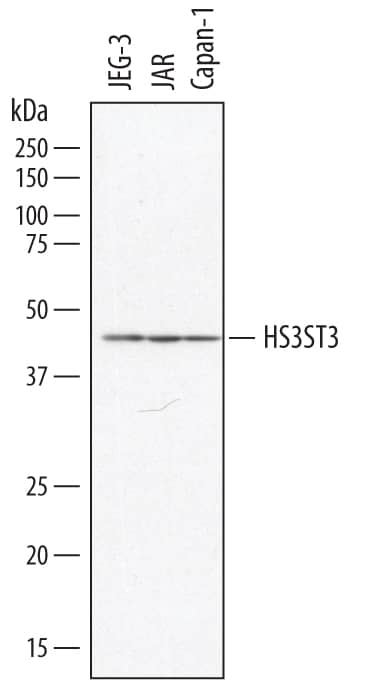Human Heparan Sulfate Glucosamine 3‑O‑Sulfotransferase 3 Antibody
R&D Systems, part of Bio-Techne | Catalog # AF7276

Key Product Details
Species Reactivity
Validated:
Human
Cited:
Human
Applications
Validated:
Western Blot
Cited:
Immunocytochemistry, Western Blot
Label
Unconjugated
Antibody Source
Polyclonal Sheep IgG
Product Specifications
Immunogen
Chinese hamster ovary cell line CHO-derived human Heparan Sulfate Glucosamine 3-O-Sulfotransferase 3
Gly60-Asp390
Accession # Q9Y662
Gly60-Asp390
Accession # Q9Y662
Specificity
Detects human Heparan Sulfate Glucosamine 3-O-Sulfotransferase 3 in direct ELISAs and Western blots. In direct ELISAs, less than 1% cross‑reactivity with recombinant human (rh) HS3ST4, rhHS2ST1, rhHS6ST1, and recombinant mouse HS6ST3 is observed.
Clonality
Polyclonal
Host
Sheep
Isotype
IgG
Scientific Data Images
Detection of Human Heparan Sulfate Glucosamine 3‑O‑Sulfotransferase 3 by Western Blot.
Western blot shows lysates of JEG-3 human epithelial choriocarcinoma cell line, JAR human choriocarcinoma cell line, and Capan-1 human pancreatic adenocarcinoma cell line. PVDF membrane was probed with 0.5 µg/mL of Sheep Anti-Human Heparan Sulfate Glucosamine 3-O-Sulfotransferase 3 Antigen Affinity-purified Polyclonal Antibody (Catalog # AF7276) followed by HRP-conjugated Anti-Sheep IgG Secondary Antibody (Catalog # HAF016). A specific band was detected for Heparan Sulfate Glucosamine 3-O-Sulfotransferase 3 at approximately 46 kDa (as indicated). This experiment was conducted under reducing conditions and using Immunoblot Buffer Group 1.Applications
Application
Recommended Usage
Western Blot
0.5 µg/mL
Sample: JEG‑3 human epithelial choriocarcinoma cell line, JAR human choriocarcinoma cell line, and Capan‑1 human pancreatic adenocarcinoma cell line
Sample: JEG‑3 human epithelial choriocarcinoma cell line, JAR human choriocarcinoma cell line, and Capan‑1 human pancreatic adenocarcinoma cell line
Formulation, Preparation, and Storage
Purification
Antigen Affinity-purified
Reconstitution
Sterile PBS to a final concentration of 0.2 mg/mL. For liquid material, refer to CoA for concentration.
Formulation
Lyophilized from a 0.2 μm filtered solution in PBS with Trehalose. *Small pack size (SP) is supplied either lyophilized or as a 0.2 µm filtered solution in PBS.
Shipping
Lyophilized product is shipped at ambient temperature. Liquid small pack size (-SP) is shipped with polar packs. Upon receipt, store immediately at the temperature recommended below.
Stability & Storage
Use a manual defrost freezer and avoid repeated freeze-thaw cycles.
- 12 months from date of receipt, -20 to -70 °C as supplied.
- 1 month, 2 to 8 °C under sterile conditions after reconstitution.
- 6 months, -20 to -70 °C under sterile conditions after reconstitution.
Background: Heparan Sulfate Glucosamine 3-O-Sulfotransferase 3
References
- Bernfield, M. et al. (1999) Annu. Rev. Biochem. 68:729.
- Esko, J.D. and Selleck, S.B. (2002) Annu. Rev. Biochem. 71:435.
- Shworak, N.W. et al. (1999) J. Biol. Chem. 274:5170.
- Xu, D. et al. (2005) Biochem. J. 386:451.
- Liu, J. et al. (1999) J. Biol. Chem. 274:5185.
- Mochiziki, H. (2008) J. Biol. Chem. 283:31237.
- Moon, A.F. et al. (2004) J. Biol. Chem. 279:45185.
- Prather, B. et al. (2012) Anal. Biochem. in press.
Long Name
Heparan Sulfate Glucosamine 3-O-Sulfotransferase 3B1
Alternate Names
3OST3B1, Heparan Sulfate Glucosamine 3OSulfotransferase 3
Gene Symbol
HS3ST3B1
UniProt
Additional Heparan Sulfate Glucosamine 3-O-Sulfotransferase 3 Products
Product Specific Notices
For research use only
